A Cost–Benefit Analysis Simulation for the Digitalisation of Cold Supply Chains
Abstract
1. Introduction
2. Background
2.1. Modelling Supply Chains
2.2. Optimisation Methods for Supply Chains
2.3. Proposed Approach
- Dynamic pricing—By adjusting prices in real-time based on supply and demand, companies can better match supply with demand, reducing waste [25].
- Inventory management—By optimising inventory levels and reducing excess inventory, companies can reduce waste [26].
- Packaging design—By designing more efficient, sustainable, or smart packaging, companies can reduce waste in the supply chain [27].
3. Modelling a General Digitalised Cold Distribution Chain
3.1. Conceptual Model of a General Digitalised Cold Distribution Chain
3.2. Model Operation
- The Customer(s)
- The Supplier(s)
- The Carrier(s)
- The Order(s)
3.3. Agent Behaviour
3.3.1. The Customer Agents
3.3.2. The Supplier Agents
3.3.3. The Carrier Agents
4. Using the Model to Evaluate Digitalisation of the UK Beef CSC
4.1. Case Study—UK Beef CSC
4.2. Optimiser Implementation
- Computes the pair-wise distances between the carriers out on delivery and customers, and one additional carrier the will be leaving the distribution site.
- Determine the minimum distance travelled for carriers to reach customers.
- Re-assign carriers to customers (if required).
- Removing the spoiled Carrier being returned to the Supplier as a viable solution shrinks the solution space, making it easier/faster to find a globally optimal solution. This was done by checking if any other Customers with outstanding orders were even within range of the spoiling Carrier before running the optimiser.
- Applying integer constraints to decision variables and setting bounds based on the relevant Customers drastically reduces the solution space, improving the chance of finding a globally optimal solution. These bounds were set equal to the smallest and largest values found in the Customer’s with outstanding orders indices. For example, if there are 10 customers but only customers 2, 4, and 7 have outstanding orders, then the ESM sets the bounds as 2 and 7.
- Making population size a function of the number of decision variables improves the ESM by reducing the computational power spent on smaller scale problems, and improving the ability to find the global optimum for larger scale problems.
4.3. Performance Metrics
5. Experimental Procedure
6. Results
7. Discussion
7.1. Implications of Results
- CSCs with a low initial cost for sensorisation can expect more benefit. This could mean CSCs whose product quality can be accurately monitored using low cost sensor networks. Implementations that use cheaper sensors, such as temperature probes, and can handle more infrequent sampling times, therefore needing more lightweight connectivity hardware, will have lower setup costs [44]. Further, infrequent sampling times will reduce the subscription costs for information transfer network costs if fewer messages are required per day [39].
- By comparing data between scenarios 1, 2, and 3, it appears that a supply chain sees the greatest reduction in spoilage when Customers are arranged in a line, and no reduction when arranged in a circle. This is likely due to a line arrangement offering a larger number of re-routing options. Therefore, supply chains with a similar arrangement and the supplier at one end of the line could expect a larger benefit.
- Inclusion of spoilage models for perishable cargo in the distribution model. This would supplement a stochastic trigger, causing quality abuse. This might mean a trigger causing temperature abuse that affect the quality of the cargo using the spoilage model. This may influence where spoilage occurs during distribution, leading to more accurate results.
- Including different or multiple optimisation criteria when re-routing. In this work, only driven distance was considered, but in reality, vehicle wear and driver availability would be important factors.
- This approach could be used to investigate the relative benefits of different sensor architectures, specifically their sample rates. Different scenarios with different inter-spoilage times could be run to investigate whether a more expensive sensor network capable of more frequent sampling is worthwhile.
- This work only considers re-routing as a possible use for sensorisation. Other options that use the same sensors may exist, for example, dynamically adjusting the refrigeration.
- The impact on customer wait times and product quality could be used to make more qualitative recommendations. For instance, focus group studies could be employed to evaluate the acceptable levels of delay and product deterioration and to identify areas for improvement. By gathering detailed feedback from key stakeholders, these studies could inform the development of more effective supply chain strategies that prioritize both efficiency and quality.
7.2. Inaccuracy in Results
8. Conclusions
Author Contributions
Funding
Institutional Review Board Statement
Informed Consent Statement
Data Availability Statement
Conflicts of Interest
References
- Badia-Melis, R.; Mc Carthy, U.; Ruiz-Garcia, L.; Garcia-Hierro, J.; Villalba, J.R. New trends in cold chain monitoring applications—A review. Food Control 2018, 86, 170–182. [Google Scholar] [CrossRef]
- Kulkarni, N.S.; Niranjan, S. Multi-echelon network optimization of pharmaceutical cold chains: A simulation study. In Proceedings of the 2013 Winter Simulations Conference (WSC), Washington, DC, USA, 8–11 December 2013; pp. 3486–3498. [Google Scholar]
- Wang, J.; Wang, H.; He, J.; Li, L.; Shen, M.; Tan, X.; Min, H.; Zheng, L. Wireless sensor network for real-time perishable food supply chain management. Comput. Electron. Agric. 2015, 110, 196–207. [Google Scholar] [CrossRef]
- Jagtap, S.; Bader, F.; Garcia-Garcia, G.; Trollman, H.; Fadiji, T.; Salonitis, K. Food logistics 4.0: Opportunities and challenges. Logistics 2020, 5, 2. [Google Scholar] [CrossRef]
- Federation, U.F.D. Food and Drink Industry Report 2020. Available online: https://www.fdf.org.uk/globalassets/resources/publications/fdf-industry-report-2020.pdf (accessed on 22 February 2023).
- Martins, P.F.; Reis, L.A.; Dias, G.M. A comprehensive review of cost-benefit analysis applications in engineering projects. Eng. Proj. Organ. 2020, 10, 221–239. [Google Scholar]
- Graziano, M.; Pianesi, F.; Segnan, M. The impact of digitalization and sensorization on healthcare: A cost-benefit analysis. J. Med. Syst. 2021, 45, 343. [Google Scholar]
- Jouini, J.; Boussemart, F.; Plateau, D.; El Kamel, A. A review of cost-benefit analysis: From classical methods to recent trends. Eur. J. Oper. Res. 2019, 277, 143–156. [Google Scholar]
- Schneider, C.; Langrock, R. Cost-benefit analysis and the assessment of uncertainty. Environ. Sci. Policy 2017, 70, 1–10. [Google Scholar]
- Zhang, L.; Leach, M.; Chen, J.; Hu, Y. Sensor cost-effectiveness analysis for data-driven fault detection and diagnostics in commercial buildings. Energy 2023, 263, 125577. [Google Scholar] [CrossRef]
- Valero, M.; Schiffmann, O.; Hicks, B.; Nassehi, A. Digital Twin Design and Evaluation for Dynamically Optimised Distribution Strategy in Food Supply Chains: An Exploratory Case Study (Accepted). In Proceedings of the 32nd Conference on Flexible Automation and Intelligent Manufacturing International Conference, Porto, Portugal, 18–22 June 2023. [Google Scholar]
- Mourtzis, D. Simulation in the design and operation of manufacturing systems: State of the art and new trends. Int. J. Prod. Res. 2020, 58, 1927–1949. [Google Scholar] [CrossRef]
- Kleijnen, J.P.; Smits, M.T. Performance metrics in supply chain management. J. Oper. Res. Soc. 2003, 54, 507–514. [Google Scholar] [CrossRef]
- Van Der Vorst, J.G.; Tromp, S.O.; Zee, D.J.v.d. Simulation modelling for food supply chain redesign; integrated decision making on product quality, sustainability and logistics. Int. J. Prod. Res. 2009, 47, 6611–6631. [Google Scholar] [CrossRef]
- Fahl, S.K. Benefits of Discrete Event Simulation in Modeling Mining Processes; Education and Research Archive. 2017. Available online: https://era.library.ualberta.ca/items/3f5130af-e7ea-498b-84c8-fb1dd86accb5 (accessed on 13 February 2023).
- Kc, R.; Aalto, M.; Korpinen, O.J.; Ranta, T.; Proskurina, S. Lifecycle assessment of biomass supply chain with the assistance of agent-based modelling. Sustainability 2020, 12, 1964. [Google Scholar] [CrossRef]
- Schroeder, G.N.; Steinmetz, C.; Rodrigues, R.N.; Henriques, R.V.B.; Rettberg, A.; Pereira, C.E. A methodology for digital twin modeling and deployment for industry 4.0. Proc. IEEE 2020, 109, 556–567. [Google Scholar] [CrossRef]
- Chang, Y.H. Adopting co-evolution and constraint-satisfaction concept on genetic algorithms to solve supply chain network design problems. Expert Syst. Appl. 2010, 37, 6919–6930. [Google Scholar] [CrossRef]
- Faramarzi-Oghani, S.; Dolati Neghabadi, P.; Talbi, E.G.; Tavakkoli-Moghaddam, R. Meta-heuristics for sustainable supply chain management: A review. Int. J. Prod. Res. 2022, 61, 1979–2009. [Google Scholar] [CrossRef]
- Kumar, A.; Mangla, S.K.; Kumar, P. An integrated literature review on sustainable food supply chains: Exploring research themes and future directions. Sci. Total Environ. 2022, 821, 153411. [Google Scholar] [CrossRef]
- Jaigirdar, S.M.; Das, S.; Chowdhury, A.R.; Ahmed, S.; Chakrabortty, R.K. Multi-objective multi-echelon distribution planning for perishable goods supply chain: A case study. Int. J. Syst. Sci. Oper. Logist. 2022, 10, 2020367. [Google Scholar] [CrossRef]
- Shi, J.; Zhang, J.; Qu, X. Optimizing distribution strategy for perishable foods using RFiD and sensor technologies. J. Bus. Ind. Mark. 2010, 25, 596–606. [Google Scholar] [CrossRef]
- Amini, M.; Otondo, R.F.; Janz, B.D.; Pitts, M.G. Simulation modeling and analysis: A collateral application and exposition of RFID technology. Prod. Oper. Manag. 2007, 16, 586–598. [Google Scholar] [CrossRef]
- Sarimveis, H.; Patrinos, P.; Tarantilis, C.D.; Kiranoudis, C.T. Dynamic modeling and control of supply chain systems: A review. Comput. Oper. Res. 2008, 35, 3530–3561. [Google Scholar] [CrossRef]
- Liu, G.; Zhang, J.; Tang, W. Joint dynamic pricing and investment strategy for perishable foods with price-quality dependent demand. Ann. Oper. Res. 2015, 226, 397–416. [Google Scholar] [CrossRef]
- Sohrabi, M.; Zandieh, M.; Afshar-Nadjafi, B. An equity-oriented multi-objective inventory management model for blood banks considering the patient condition: A real-life case. Sci. Iran. 2021. [Google Scholar] [CrossRef]
- Chen, S.; Brahma, S.; Mackay, J.; Cao, C.; Aliakbarian, B. The role of smart packaging system in food supply chain. J. Food Sci. 2020, 85, 517–525. [Google Scholar] [CrossRef] [PubMed]
- Valero, M.; Hicks, B.; Nassehi, A. A Conceptual Framework of a Digital-Twin for a Circular Meat Supply Chain. In International Conference on Flexible Automation and Intelligent Manufacturing; Springer: Cham, Switzerland, 2023; pp. 188–196. [Google Scholar]
- Valero, M.; Newman, S.; Nassehi, A. Link4Smart: A New Framework for Smart Manufacturing Linking Industry 4.0 Relevant Technologies. Procedia CIRP 2022, 107, 1594–1599. [Google Scholar] [CrossRef]
- Sharma, A.; Abbas, H.; Siddiqui, M.Q. Modelling the inhibitors of cold supply chain using fuzzy interpretive structural modeling and fuzzy MICMAC analysis. PLoS ONE 2021, 16, e0249046. [Google Scholar] [CrossRef] [PubMed]
- Borshchev, A.; Brailsford, S.; Churilov, L.; Dangerfield, B. Multi-method modelling: AnyLogic. In Discrete-Event Simulation and System Dynamics for Management Decision Making; John Wiley & Sons: Hoboken, NJ, USA, 2014; pp. 248–279. [Google Scholar]
- Law, A. Simulation Modeling and Analysis; McGraw-Hill Education: New York, NY, USA, 2014. [Google Scholar]
- Park, N. Population Estimates for the UK, England and Wales, Scotland and Northern Ireland, Provisional: Mid-2020; Office for National Statistics: Hampshire, UK, 2021.
- Gustafsson, J.; Cederberg, C.; Sonesson, U.; Emanuelsson, A. The Methodology of the FAO Study: “Global Food Losses and Food Waste-Extent, Causes and Prevention”-FAO, 2011; SIK Institutet för livsmedel och bioteknik: Göteborg, Sweden, 2013. [Google Scholar]
- Fernandes, R.; TURNER, M.; Taylor, S. Evaluation of the National HGV Speed Limit Increase in England and Wales; Department for Transport: London, UK, 2020. [Google Scholar]
- Beamon, B.M. Measuring supply chain performance. Int. J. Oper. Prod. Manag. 1999, 19, 275–292. [Google Scholar] [CrossRef]
- Hoc, A. Advisory Committee on the Microbiological Safety of Food; Food Standards Agency: London, UK, 2007.
- Carullo, A.; Corbellini, S.; Parvis, M.; Vallan, A. A wireless sensor network for cold-chain monitoring. IEEE Trans. Instrum. Meas. 2008, 58, 1405–1411. [Google Scholar] [CrossRef]
- Microsoft Azure Pricing Calculator. Available online: https://azure.microsoft.com/en-gb/pricing/calculator/ (accessed on 13 February 2023).
- Wang, N.; Hughes, B.W. Efficiency and the Mitigation of Carbon Emissions in Semi-Truck Transportation. Ph.D. Thesis, Massachusetts Institute of Technology, Cambridge, MA, USA, 2022. [Google Scholar]
- FleetNews Car Fuel Cost Calculator. Available online: https://www.fleetnews.co.uk/costs/fuel-cost-calculator/?FuelType=Diesel&PencePerLitre=170.20&Mileage=238.84&ManufacturerId=7&Mpg=18.78# (accessed on 13 February 2023).
- Indeed Truck Driver Salary in United Kingdom. Available online: https://uk.indeed.com/career/truck-driver/salaries (accessed on 13 February 2023).
- Dal-Mas, M.; Giarola, S.; Zamboni, A.; Bezzo, F. Strategic design and investment capacity planning of the ethanol supply chain under price uncertainty. Biomass Bioenergy 2011, 35, 2059–2071. [Google Scholar] [CrossRef]
- Firouz, M.S.; Mohi-Alden, K.; Omid, M. A critical review on intelligent and active packaging in the food industry: Research and development. Food Res. Int. 2021, 141, 110113. [Google Scholar] [CrossRef]
- Kis, Z. Stability modelling of mRNA vaccine quality based on temperature monitoring throughout the distribution chain. Pharmaceutics 2022, 14, 430. [Google Scholar] [CrossRef]

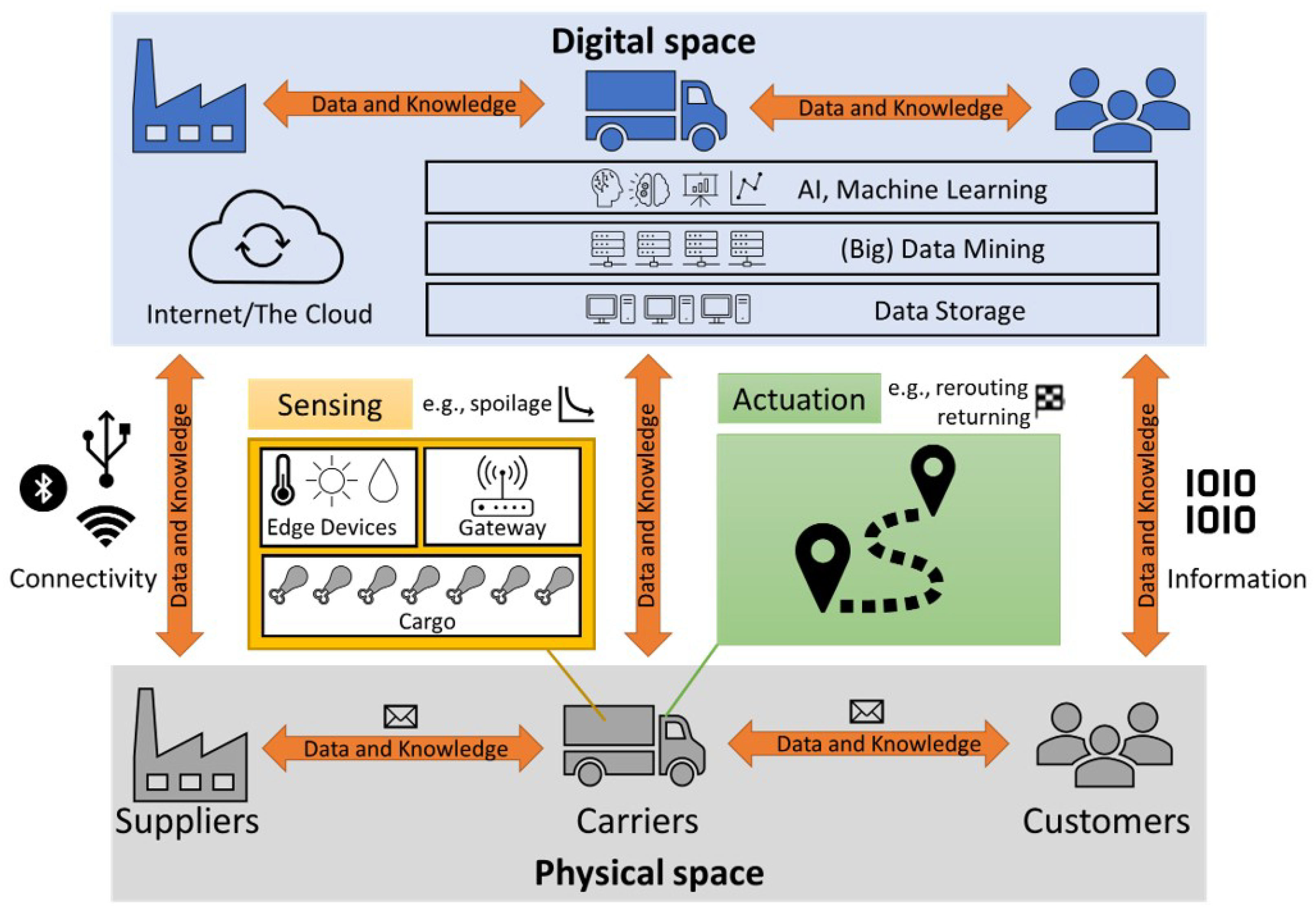
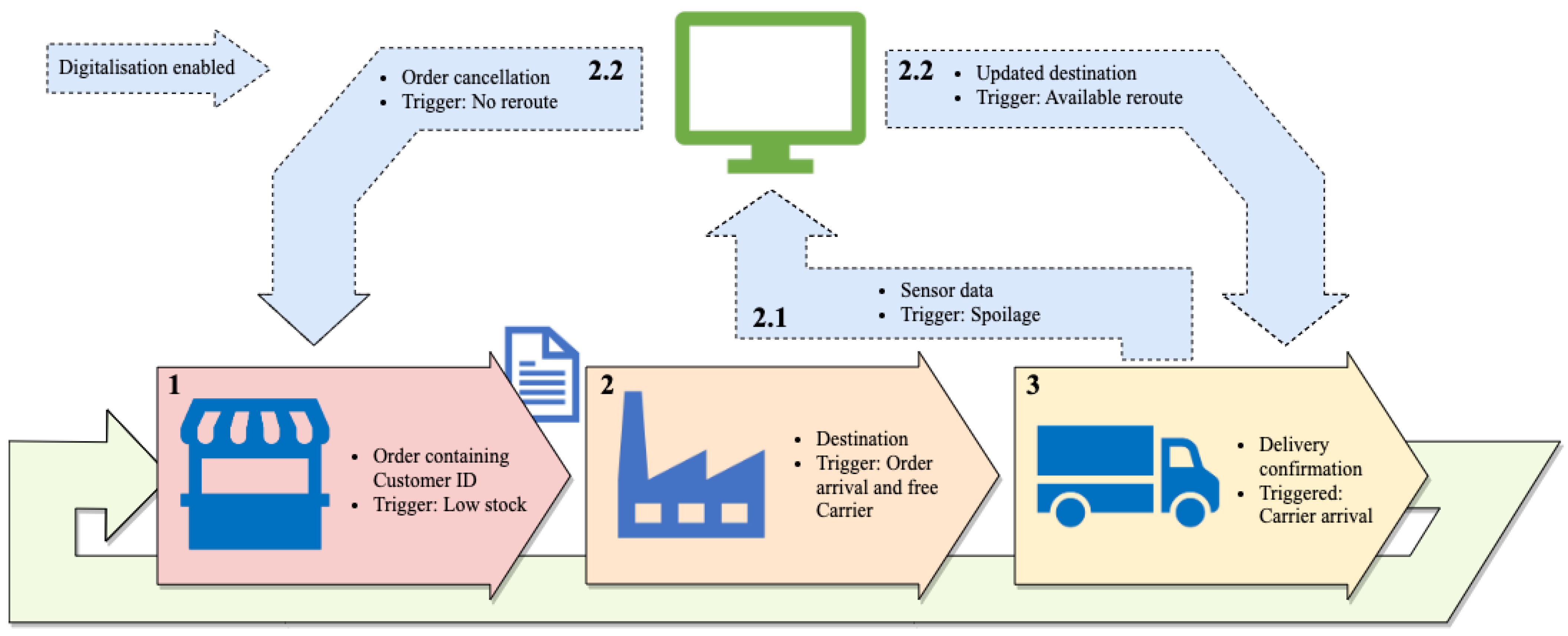
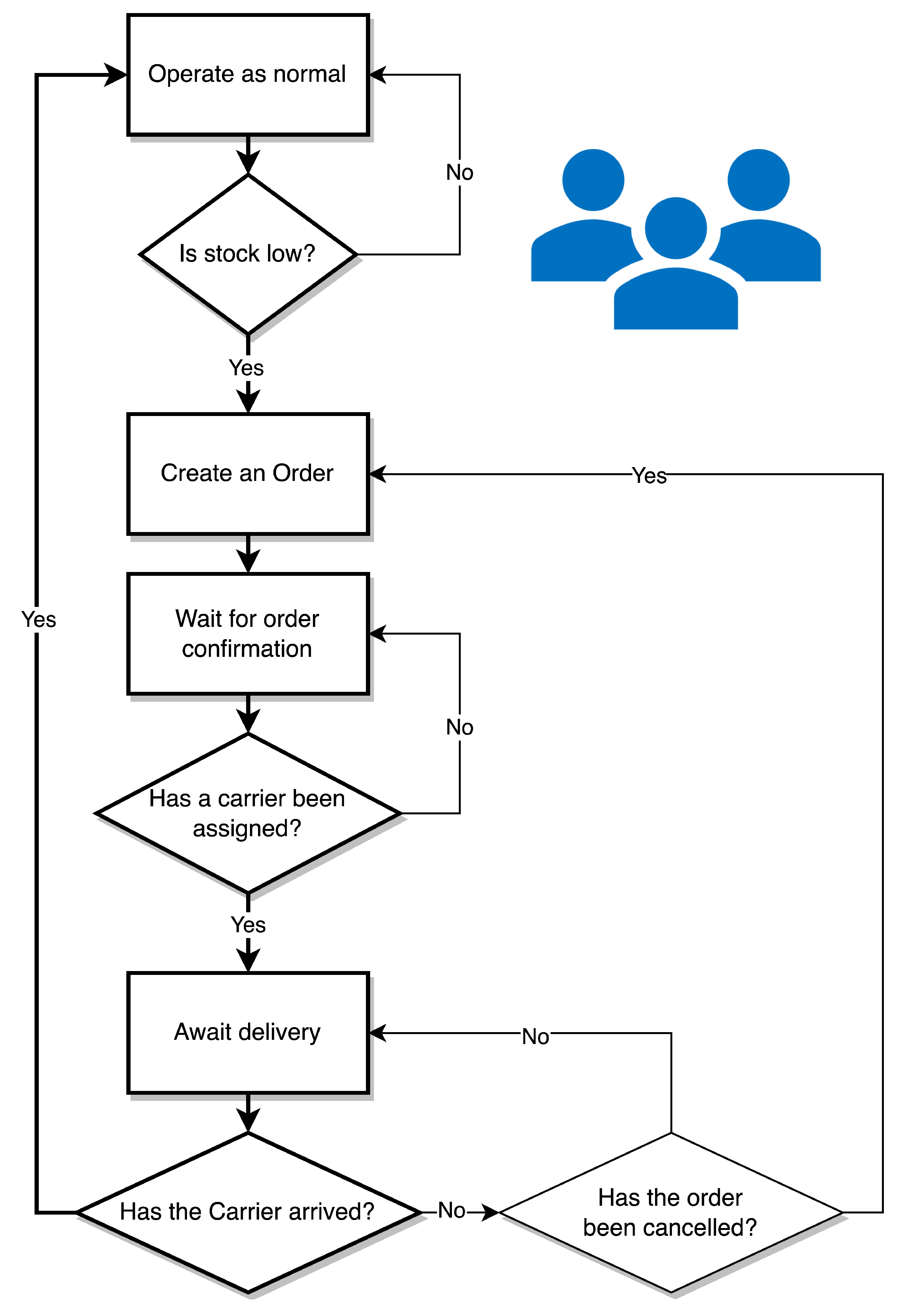
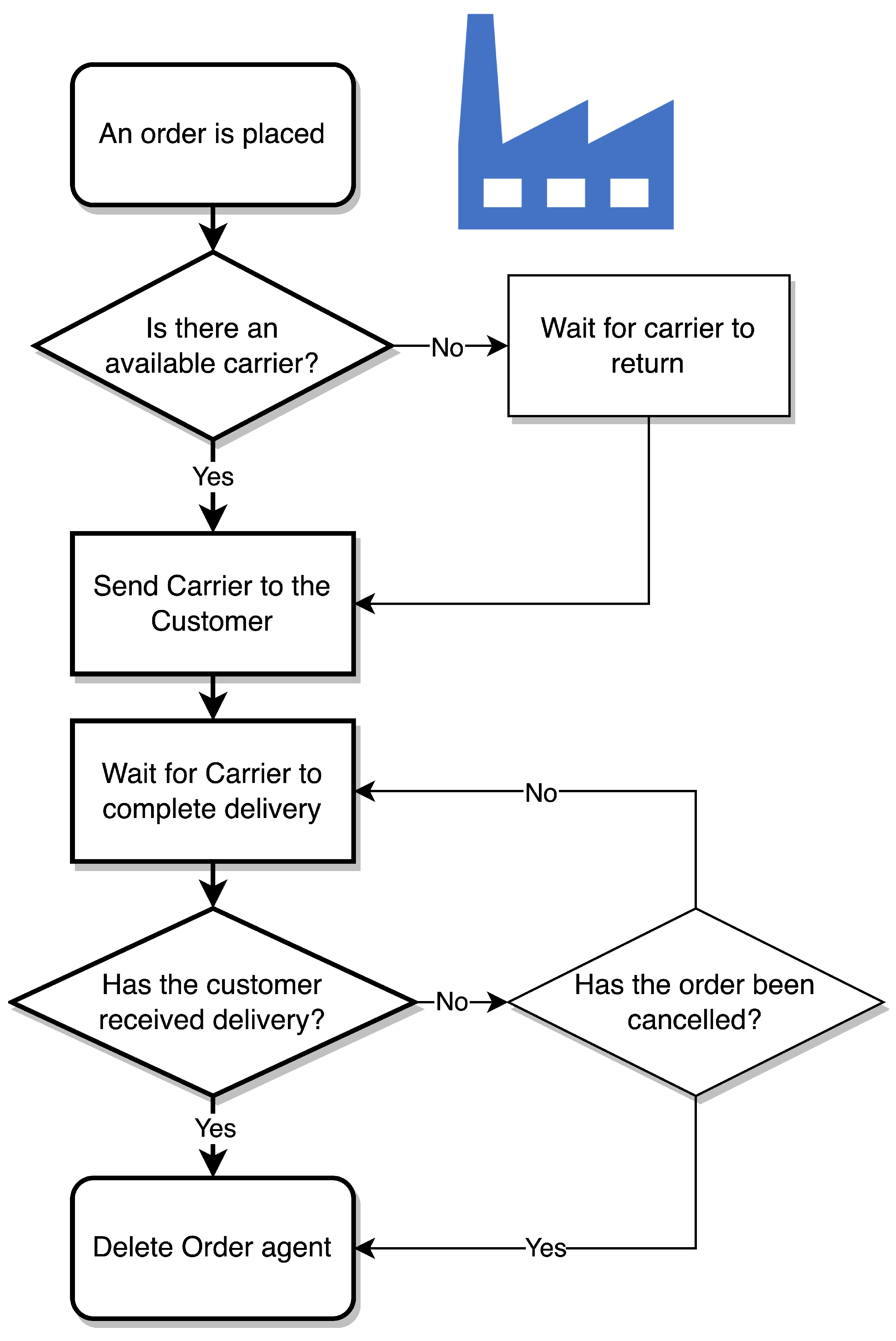
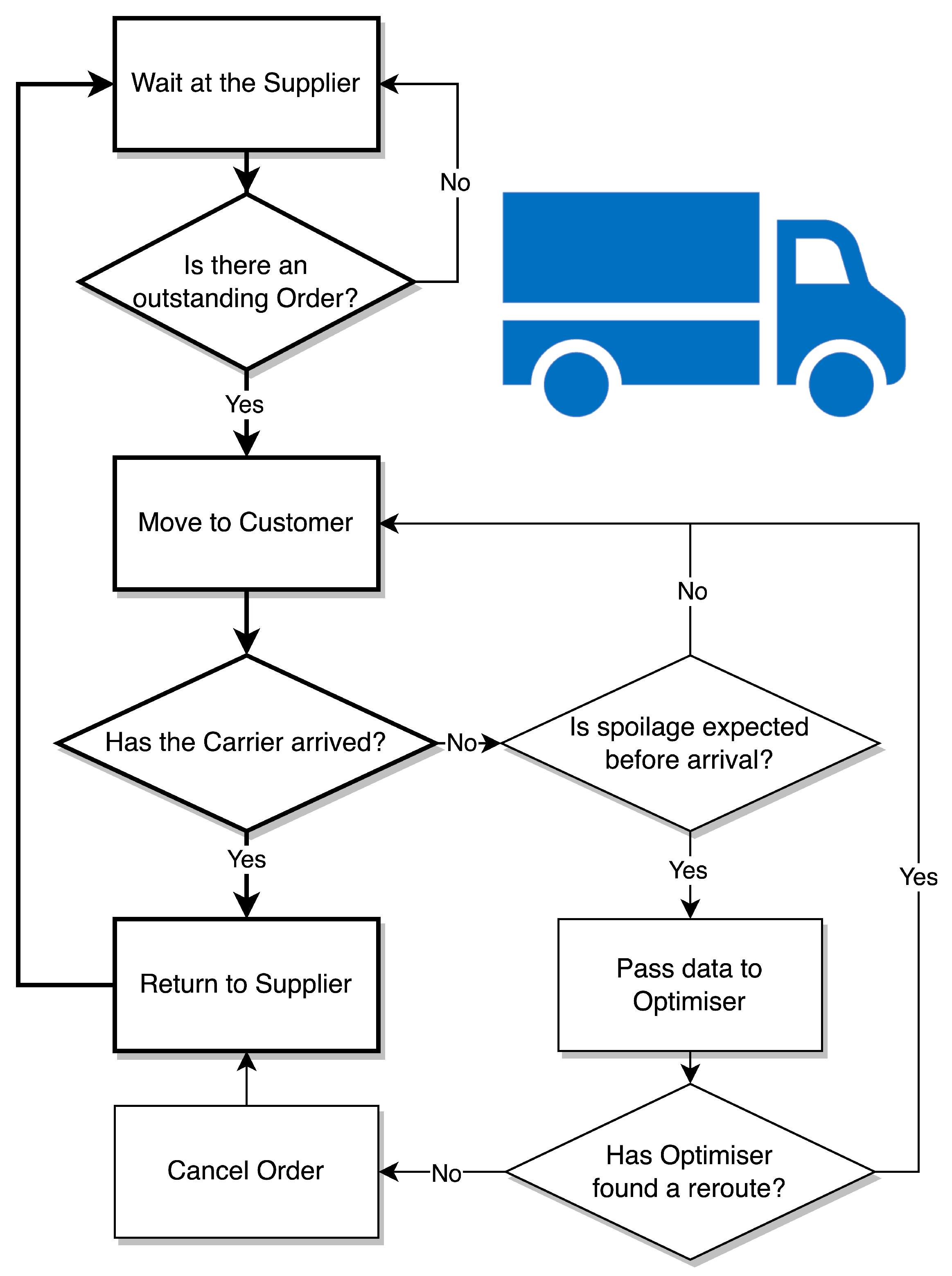
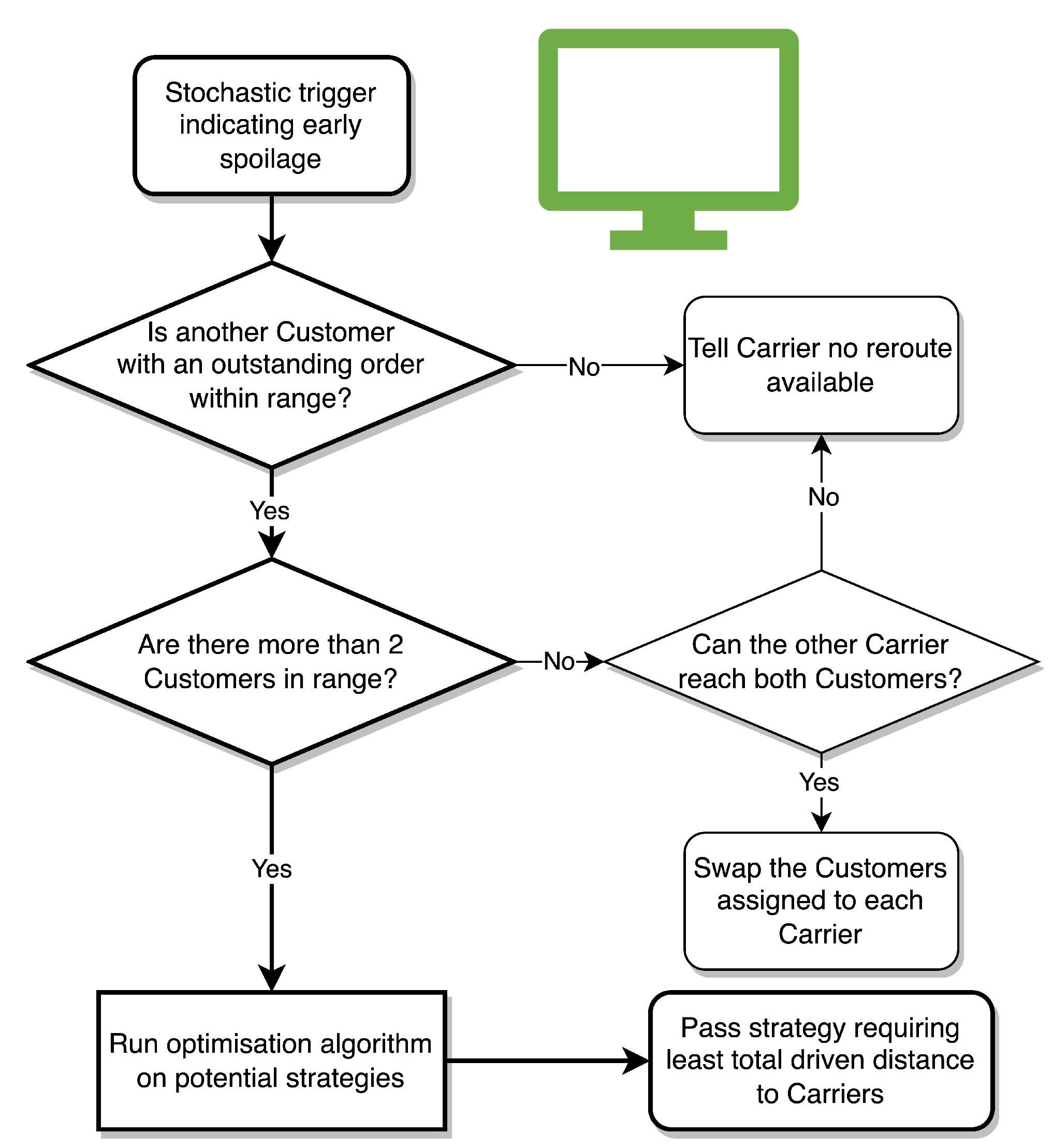
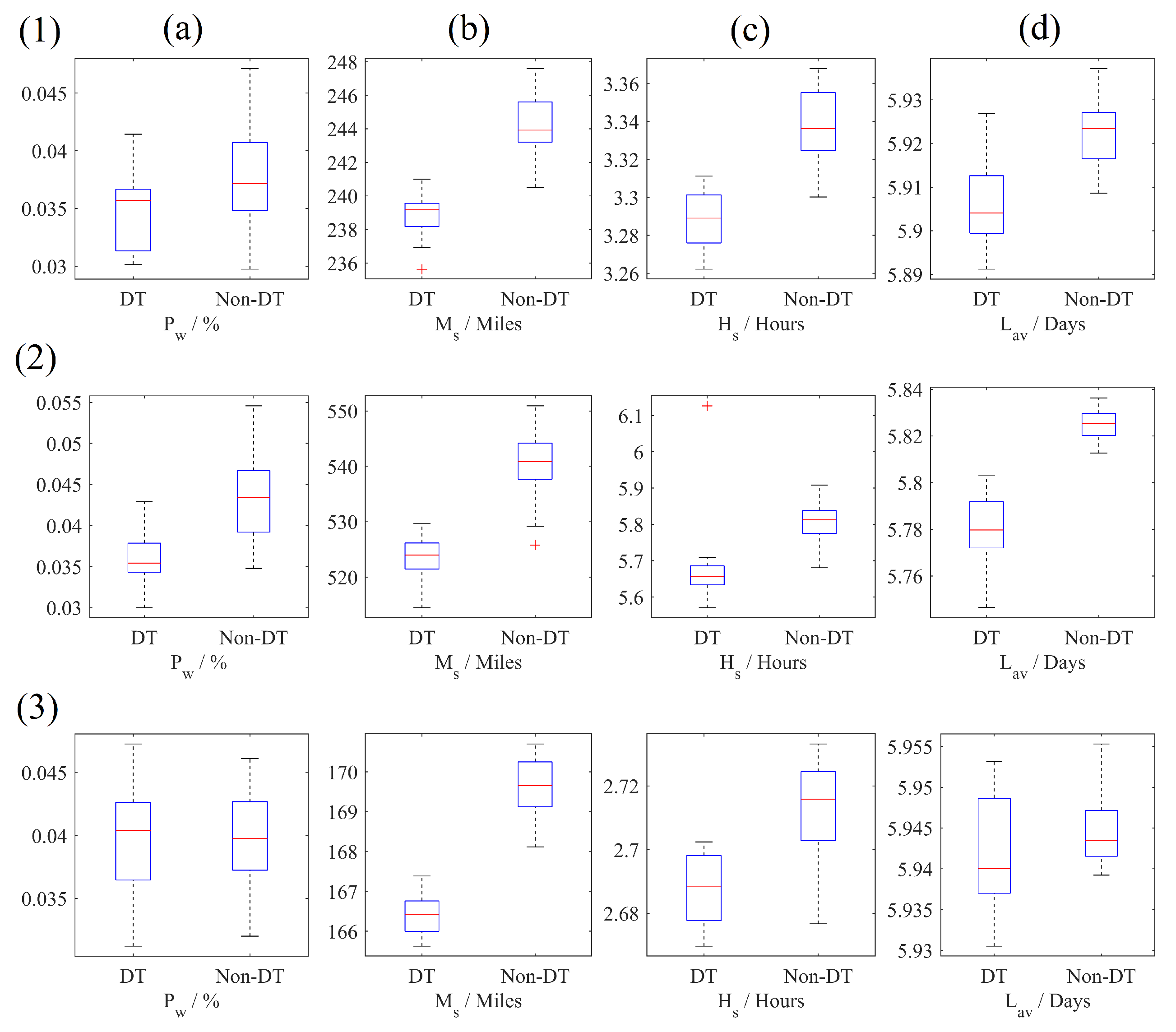

| # | Feature | Utility |
|---|---|---|
| 1 | Multi-method modelling | Allows models to combine DES and ABM, both of which are required for the described modelling approach [14,16]. Single method approaches will require cumbersome workarounds [31]. |
| 2 | Integrated geographic information system (GIS) functionality | Enables easy and accurate calculation of travel distances between agents, providing an easy metric to base optimiser decisions on. Also enables effortless creation of numerous pathways between agents. This makes the creation of unique options for vehicle re-routing simple. |
| 3 | Established simulation | Error detection is made much easier than in a model created in a general purpose programming language. In addition, a natural framework for model construction is provided, reducing the time and effort required to adopt this approach [32]. |
| 4 | Easy implementation of stochastics/statistical distributions | Generation of a vast number of unique scenarios is made simple. Representation of stochastic events such as spoilage and order placement is easy. |
| # | Excel Feature | Benefits When Applied to This Work |
|---|---|---|
| 1 | Ubiquity of Excel in industry | The optimisation method described in this work can be easily adopted by most readers. |
| 2 | Application of heuristics through Solver | The Solver add-in for Excel makes the application of a variety of heuristics simple. This means the structure of the optimisation problem is not such a concern. |
| 3 | Compatibility through Visual Basic for Applications (VBA) | The Solver add-in, as well as other features, are compatible with VBA. This will make the execution of the Optimiser during the simulation more streamlined and ease data collection. |
| Number | Generalised Terminology/Feature | Case Study in AnyLogic Terminology/Feature | Quantity |
|---|---|---|---|
| 1 | Customers | UK beef vendors (supermarkets, butchers, restaurants) placed according to population density. | 10 |
| 2 | Suppliers | A beef packaging facility located on the Welsh border. | 1 |
| 3 | Carriers | Fleet of delivery trucks. | 4 |
| 4 | Orders | Order of beef. Order size is not considered. | - |
| 5 | Optimiser | Evolutionary algorithm applied using Solver add-in. | - |
| 6 | Carrier data | GPS co-ordinates and shelf life of shipment. | - |
| 7 | Stochastic spoilage trigger | A rate for spoilage that calibrated the non-digitalised supply chain to have a spoilage rate of 4% [34]. | - |
| 8 | Stochastic order trigger | An exponential distribution with a mean of 1 week. | - |
| # | Assumption |
|---|---|
| 1 | All deliveries are carried out using the UK’s road network. |
| 2 | Truck fleet is homogeneous, providing equal refrigeration, having an equal mean speed of 60 MPH [35]. |
| 3 | Trucks do not wear, and driver constraints are not considered. |
| 4 | Disposal of spoiled shipments occurs at the Supplier and is instant. |
| 5 | Suppliers have an unlimited stock. |
| 6 | Sampling frequency of sensor network is high, so shipments can spoil anywhere along their journey. |
| 7 | Shipments spoil entirely and there is no option for partial delivery. |
| 8 | The causes of spoilage are unimportant and not distinguished. |
| 9 | Order size is not considered and there is only one type of product. |
| 10 | Orders are always of the same, maximum quality/shelf life at the Supplier. |
| Scenario | [%] | [Miles] | [Hours] | [Days] | ||||
|---|---|---|---|---|---|---|---|---|
| DT | Non-DT | DT | Non-DT | DT | Non-DT | DT | Non-DT | |
| 1 | 3.48 | 3.81 | 238.84 | 244.25 | 3.29 | 3.34 | 5.91 | 5.92 |
| 2 | 3.57 | 4.19 | 523.33 | 540.33 | 5.67 | 5.81 | 5.78 | 5.78 |
| 3 | 3.97 | 3.94 | 166.39 | 169.59 | 2.69 | 2.71 | 5.94 | 5.94 |
| No. | Parameter | Value | Unit | Used to Find | Source |
|---|---|---|---|---|---|
| 1 | Number of Carriers | 4 | N/A | 3 | Table 3 |
| 2 | Sampling Frequency | 1 | minutes | 3 | [38] |
| 3 | Maximum possible Messages per Day | 5760 | days | Cost of IoT hub | Calculation |
| 4 | Cost of IoT hub, | 0 | GBP/year | Payback time | [39] |
| 5 | Mean Number of Shipments per Year, | 852 | years | 9, 14, and Payback time | Simulations |
| 6 | Improvement in , | 0.33 | % | Payback time | Table 5 |
| 7 | Carrier Miles per Gallon | 18.78 | MPG | 10 | [40] |
| 8 | Mean Miles Saved per Successful Delivery | 5.41 | miles | 9, 13 | Table 5 |
| 9 | Mean Miles Saved per Year | 4607.16 | miles/year | 11 | Calculation |
| 10 | Price of Diesel per Mile | 0.4072 | GBP/mile | 11 | [41] |
| 11 | Savings on Diesel, | 1876.15 | GBP/year | Payback time | Calculation |
| 12 | Mean Truck Speed | 60 | MPH | 13 | Table 4 |
| 13 | Driving time saved per Successful Delivery | 0.09 | hours | 14 | Calculation |
| 14 | Time Saved per Year | 76.79 | hours/year | 16 | Calculation |
| 15 | Truck Driver Hourly Wage | 15.73 | GBP/hour | 16 | [42] |
| 16 | Savings on Driver Wages, | 1207.84 | GBP/year | Payback time | Calculation |
| # | Sources of Error | Effect |
|---|---|---|
| 1 | The GIS functionality in AnyLogic is accurate and any inaccuracies in delivery distance are likely to be negligible. | N/A |
| 2,3 | In reality, trucks within a delivery fleet would differ from each other in a number of ways: vehicle wear, driver ability/choices, model, and size. The most significant of these factors is model and size. Different models may have different fuel efficiencies and accelerations. However, due to the average delivery time being far greater than refuelling times and routes often using motorways, the model of truck can be ignored. The size of the truck may limit the orders that it can take, which may reduce the number of available trucks at times. However, since order size was ignored; this will not introduce an inaccuracy in the results. All trucks were assigned a speed of 60MPH. In reality, their average speed would be slower due residential areas along the delivery route, refuelling, etc. Readers seeking to implement this approach might be able to obtain a more accurate value for the average speed of their carriers, reducing this inaccuracy. | may be slightly longer in reality and may be slightly shorter. |
| 4 | This assumption simplifies the scenario by reducing the number of actors and enables trucks containing spoiled cargo to be available as soon as disposal was completed. If a disposal centre was located elsewhere or disposal was not instant, then this may reduce the average number of available trucks, extending time spent waiting for an order and increasing the miles driven by each truck. | and may be increased. |
| 5 | A Supplier running low on stock, in this case beef, may be caused by a shortage of that product. If Suppliers limit the amount of orders they promise to deliver, then none of the PMs should be affected. would only be increased if Suppliers confirm orders that they do not have the stock for. | N/A |
| 6 | The sampling frequency of the sensor network required to support the data collection used for dynamic re-routing may range from seconds to minutes or more depending on power requirements, data storage, connectivity, etc. In reality, it would most likely be less than several minutes [38]. The implication of this is that spoilage may occur between samples and cause a truck to take a slightly less optimal route. This might have a small negative affect on all PMs. | A small to negligible negative effect of all PMs. |
| 7 | Order size is not considered in this model; however, partial delivery/spoilage could be considered if it acted as a modifier to customer’s time between orders, and was included in strategy optimisation. If this level of abstraction was chosen, then the percentage of shipments wasted should be reduced as well as time spent waiting for an order. It maybe increases the miles driven to deliver the same amount of product, and the average surplus shelf life of delivered product would decrease. | Increased values of . Decreased values of , , and . |
| 8 | The model was calibrated such that the values for spoilage during distribution match those found in literature. Since order size is also not considered, then the cause of spoilage should not provide different strategy options even if it was considered, as there would be no option for partial delivery if a single piece of packaging was faulty, for example. The cause of spoilage may affect the remaining shelf life of products if it was a temperature abuse affecting all the Carrier’s cargo, for example. However, if shipments spoil for any reason, they would not be included in the PM, so considering spoilage causes still would not affect PM accuracy. | N/A |
| 9 | If order size were considered, then this might substantially reduce the options for re-routing, unless partial delivery was also allowed. In either case, this would probably increase the amount of miles driven to deliver the same amount of product. It might increase the hours spent waiting and the amount of cargo wasted if partial delivery is not allowed. The surplus shelf life might increase if there is not partial delivery, as more often deliveries will have to come straight from the Supplier and not via a re-route. | If partial delivery is not also included, then all PMs may increase. |
| 10 | If cargo had varying quality at the supplier, then the amount of wasted cargo can only increase as currently it is always of maximum quality. This should also increase the miles driven and hours spent waiting per delivery. It should also reduce the surplus shelf life, as product will start with a smaller shelf life. | Increased values of , , and . Decreased values of . |
Disclaimer/Publisher’s Note: The statements, opinions and data contained in all publications are solely those of the individual author(s) and contributor(s) and not of MDPI and/or the editor(s). MDPI and/or the editor(s) disclaim responsibility for any injury to people or property resulting from any ideas, methods, instructions or products referred to in the content. |
© 2023 by the authors. Licensee MDPI, Basel, Switzerland. This article is an open access article distributed under the terms and conditions of the Creative Commons Attribution (CC BY) license (https://creativecommons.org/licenses/by/4.0/).
Share and Cite
Schiffmann, O.; Hicks, B.; Nassehi, A.; Gopsill, J.; Valero, M. A Cost–Benefit Analysis Simulation for the Digitalisation of Cold Supply Chains. Sensors 2023, 23, 4147. https://doi.org/10.3390/s23084147
Schiffmann O, Hicks B, Nassehi A, Gopsill J, Valero M. A Cost–Benefit Analysis Simulation for the Digitalisation of Cold Supply Chains. Sensors. 2023; 23(8):4147. https://doi.org/10.3390/s23084147
Chicago/Turabian StyleSchiffmann, Oliver, Ben Hicks, Aydin Nassehi, James Gopsill, and Maria Valero. 2023. "A Cost–Benefit Analysis Simulation for the Digitalisation of Cold Supply Chains" Sensors 23, no. 8: 4147. https://doi.org/10.3390/s23084147
APA StyleSchiffmann, O., Hicks, B., Nassehi, A., Gopsill, J., & Valero, M. (2023). A Cost–Benefit Analysis Simulation for the Digitalisation of Cold Supply Chains. Sensors, 23(8), 4147. https://doi.org/10.3390/s23084147









